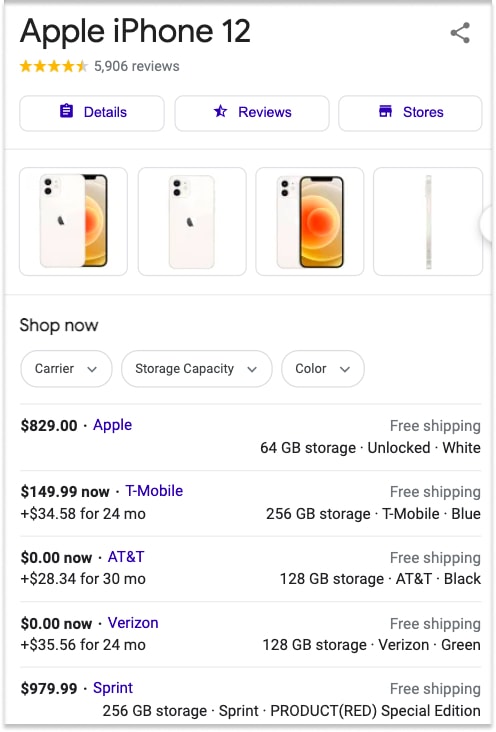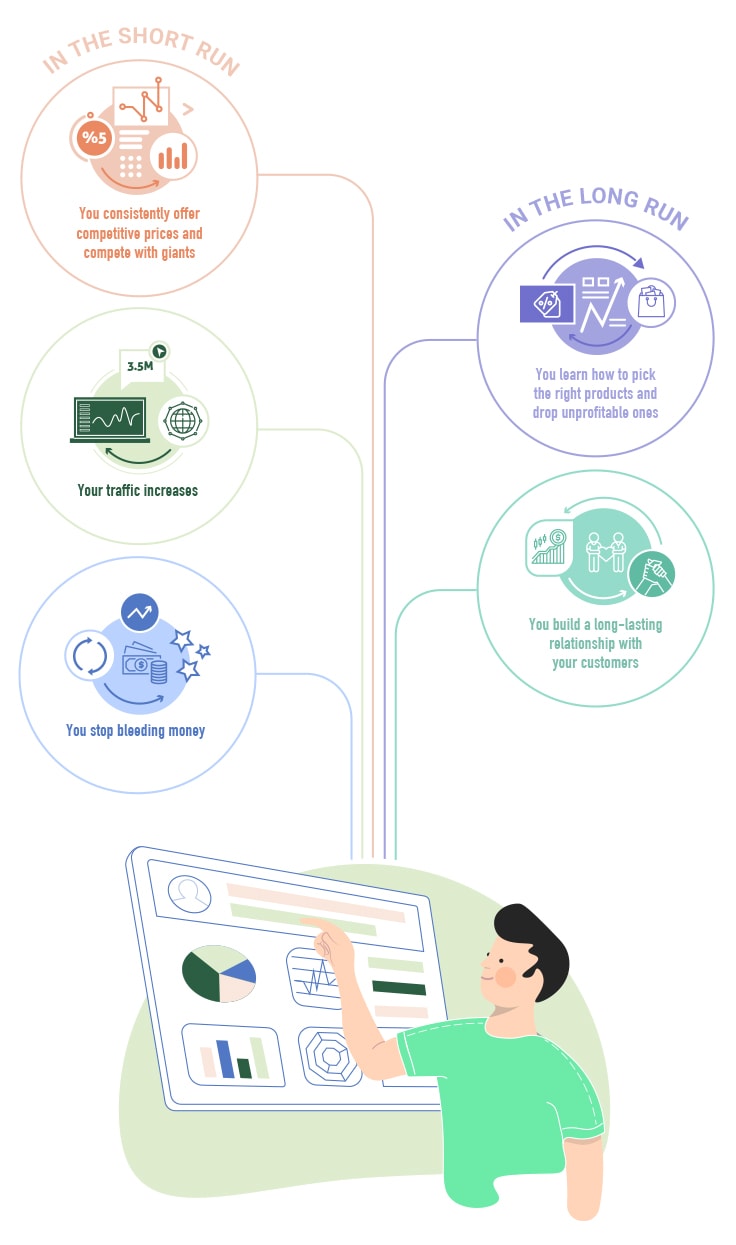Dynamic pricing sounds complicated. It’s not, though. It’s just a matter of time before most online sellers use dynamic pricing regularly because it’s simply more profitable than any other ecommerce pricing strategy.
We’ll talk about the whys and hows, but first let’s put together a very clear definition of dynamic pricing with dynamic pricing examples to make sure we don’t get confused at some point.
What is it?
Dynamic pricing meaning: dynamic pricing is a strategy where you change prices based on changing market trends and conditions.

In a fast-paced environment like ecommerce, it gives you the flexibility you need.
What does fast-paced mean?
Imagine—or remember, if you’ve been through—the times when people only had access to local stores. On rare occasions, they’d go to the next town, usually for a wider product range or better prices.
Other times, they’d be okay with what the mom-and-pop store down the street sells.
That was a different world.
Today, information is everywhere. You don’t need to step foot outside to know what’s sold where, or to buy anything. You can buy literally anything from the comfort of your couch at the best price.
Think of your own buying experience.
How do you start your buying journey?

Let’s imagine the common scenarios you go through when buying something.
When you know exactly what you need
We all make repeat purchases. If you’re pleased with a specific brand and model, you don’t go looking for a substitute, right?
For instance, if you’re happy with the performance of your regular cell battery, you stick with it. Most likely because it satisfies your requirements. And the time you’d spend to find a better product is not worth it, and you’re not even sure if there’s a better model.
This also holds true for brands we’re loyal to. Think of Apple fans. You can’t make them believe iPods are overpriced. Because they don’t expect affordable prices, and Apple doesn’t offer that.
So, what do those Apple fans do when they want a brand new iPhone 12?
They Google it and see this:

A thousand stores selling identical iPhone 12s.
Naturally, the first thing they check is the price.
It wouldn’t be wrong to say, in this scenario—where you shop for a specific model and brand—, price is the most important difference between those results.
And as soon as you search for a product, you see price information.
But what about the times when you have a need but haven’t decided on a brand or product yet?
When you have a specific need, not a model or brand in mind
When was the last time you bought an electronic product?
You usually look for a buying guide or watch some YouTube speed tests or comparison videos.
Things like TVs or white goods. They cost a large portion of our income (with a simple price/income calculation). Most people certainly put some thought into price and affordability.
That’s why there is a buying guide out there for every budget.
Don’t you have a constant price/performance calculation going on at the back of your mind at this stage?

This or that brand might have a design advantage over the other, but is that really worth the extra $150? Even if you don’t do it deliberately, your mind does it for you.
Because people have reference prices in their minds. Since we’re exposed to infinite price tags every day, we usually have an idea of how much something should cost us.
For instance, you know that the coffee from a shop down the street shouldn’t cost you $30—perhaps it can, in an entirely different context. That’s an example of how reference prices work.
The bottom line is, even if not purposeful, there’s a price comparison in process.
But what do all these have to do with dynamic pricing?
Dynamic ecommerce environment calls for an agile approach
Online prices are transparent.
You, your existing customers, prospects, and rivals—you all can see price data once it’s on the web.
Compared to those times before online selling took over the world, you can make more, much more rational buying decisions. And this transparency creates a dynamic:
- Shoppers compare online prices so easily (we’ll touch on this later)
- Seasoned sellers are aware of this price transparency and the fact that they have to compete on price
- Prices change frequently
- Small businesses stick with the same prices for too long, can’t compete on price, seem too expensive to shoppers, and leave too much money on the table (we’ll examine why)
But why most small businesses can’t offer competitive prices?
Is it because those retail giants are inevitably superior? At times it may feel like that, but that’s definitely not the case.
A small business can thrive in the e-commerce market as well.
The key is to take an agile and data-driven approach to pricing.
Here’s what it means:

And these happen once you build such an agile system:

In other words, this dynamic approach gives you the chance to make your customers happy and improve profitability at the same time.
How do you do it?
How to use dynamic pricing strategies
Step 1: Find a purpose for your products
Now, if you came this far, you realize we’re talking about a shift in your approach to pricing. And it’s only possible if you price a product with a purpose in mind.
As a first step, divide your products based on how you’ll use them to achieve different results.
For instance, popular products are excellent at driving traffic. Why not use them to increase your store’s visibility?
Price them below your competitors’ offers. If you’re worried about how much doing this will cost you remember that an average person sees between 6.000 to 10.000 ads in a day. How do you think your ad budget differs from this?
Think of it as a very subtle ad.
When you offer competitive prices, price comparison sites like Bizrate (US), Idealo (GR), Kakaku (JP), PriceRunner (UK), and Google Shopping help you expand your reach to their own audiences. And their traffic is so wild, you don’t want to miss out on that.
So let’s say you’re selling an Xbox. Naturally, its accessories are also available on your website.
Now, one way to make up for cutting into your margins is selling accessories and associated items a bit more expensive than others do.
In the Xbox case, the associated product might be charge stands for controllers, adapter cables, etc.
So in a sense, dynamic pricing strategies give you total control over your price positioning (where your prices stand in the market), and by extension, help you shape how customers perceive your store, in comparison to rivals, when you have a purpose.
Step 2: Track your competitors
Tracking your competitors is vital. You need their pricing information to set your own prices, for all the reasons we’ve talked about.
And there are three common price monitoring methods.
Manual tracking
If you sell a very limited number of products, manual tracking is an option. Let’s say it takes 30 seconds to go to a competitor’s website, look for a product’s price, and record it in a spreadsheet. How much time does it take for you to complete that cycle once?
If you sell 50 products on your website and have 10 big competitors, it’ll take slightly over 4 hours.
Considering how frequently online prices change, your data is likely to become obsolete before it becomes useful.
Price tracking software
Using price tracking software is another option, and it’s more affordable than manual tracking, not only because it saves time, but because the clean and up-to-date data is much more valuable than what you’d have otherwise.
These tools also offer stock availability information, which is crucial in building a dynamic pricing strategy.
In-house engine
You can also have someone/a team of developers build an engine for you. Especially if you need to monitor more than just price and stock information.
But software will need maintenance. If you don’t have an in-house developer team, don’t forget that it’ll cost you a monthly/yearly fee too.
This way or another, the data you’ll collect is very important. Let’s look at how you can use it.
Step 3: Set up dynamic pricing rules
This is the part where things get dynamic.
To make timely adjustments to accommodate changing market conditions, you need at least some level of automation.
You can’t sit in front of your PC all day to make sure your prices are adjusted.
What you can do is build an in-house automation system, or use a dynamic pricing tool.
Dynamic pricing software is easy to use and affordable, whereas your own engine complies with you. But writing your own algorithm calls for technical expertise and regular maintenance.
In most cases, using software will be more than enough.
So, let’s see how it works and how to implement dynamic pricing.
Using dynamic pricing rules
The software helps you position yourself wherever you want.
All you have to do is enter your data.

Suppose you’ve got a superb supplier discount.
Now you can afford to lower your price and attract more customers.
Enter your cost, desired profit margin, and where you want to position (cheapest, 5% cheaper than the cheapest, etc.).
But how are you going to know what your profit margin should be?
Unfortunately, there’s no recipe for that. The logic behind dynamic pricing is optimization, so you have to continuously test prices.
Let’s say your cost per unit is $29. And the cheapest competitor sells it at $45.
Now, you can ask for $35, $38, $43, and so on. There are countless price points in between your cost, and what your cheapest competitor charges.
And, there’s no way of knowing what demand will be at each price point without trying them all.
That’s why you have to test continuously. Once you start testing price points, you’ll notice that even the tiniest changes can influence demand, and there’s always room for improvement.
But what if you alienate your existing customers? What do they think about constantly changing prices?
To have dynamic prices, you can use the following feature: advance filtering.
You may check to discover which competitors have raised their pricing for particular products and who has run out of stock. You can uncover actionable data more quickly by using advanced filtering to assist you in doing that and many other things. To save even more time for the next time, you may also save your specified filter. The greatest part is that you can export your filtered data to share with anybody inside or outside of your business, making it easier for you to put analysis into practice.
Does dynamic pricing alienate shoppers?
Well, it depends.
Dynamic pricing is inarguably a type of price discrimination. In some cases, it’s fair in the eyes of customers, in some, it’s not.
Back in 2000, Amazon faced serious backlash from customers. People realized they were shopping DVDs at different prices, based solely on which browser they’ve used.
Jeff Bezos had to call it a mistake and apologize. What he said was illuminating:
“We’ve never tested and we never will test prices based on customer demographics.”
That tells us what angered shoppers the most was why the company charged them more.
So your algorithm shouldn’t discriminate against a group of people based on where they live, where they work, how old they are, and so on.
But what if I want to reward my loyal customers via personalized discounts and promotions?
That’s different. Personalized discounts are shown to no one else but the recipient, and they’re unique, so others are not actually discriminated against.
Parting words
Dynamic pricing gives you the ability to adapt. It helps you position yourself wherever you want, market your products with less effort, and improve profitability whenever you can.
Use this strategy and you’ll see what you’ve been missing out on.
What do you think about dynamic pricing as a shopper/store owner?
dynamic pricingpricing strategies

Such an informative! I must say that you have done a very good research about dynamic pricing. This is really a very enlightening one. Thanks for explaining in such an elaborate manner.
Thank you, Priya, very happy to hear that!